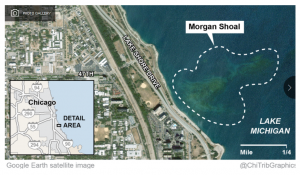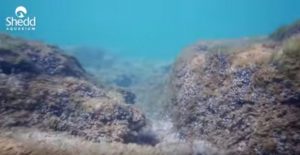Morgan Shoal: More than Sand and Mud
By Jennifer Ball
Morgan Shoal is a rocky outcrop located a few hundred yards off the shore of Hyde Park, which is known for its location of a 1914 shipwreck, the Silver Spray. But it is also the site of a lot of biodiversity. Many people drive past it on Lake Shore Drive every day and may not even know it is there. The iron boiler from the more than 100-year-old shipwreck still sits in the area.

Morgan Shoal is located a few hundred yards off the shore of Hyde Park.
The area was made of a material formed more than 400 million years ago, the compressed remains of a coral reef that was formed in shallow seas at the time. One may find the fossils of some old sponges and corals that have been embedded in the bedrock down there.
Dr. Philip Willink is a senior research biologist at the Shedd Aquarium, who has conducted research at Morgan Shoal to find out what kind of life is there and what the geology is like. They want to find out what’s down there and how it compares to other areas. Willink’s research was funded by the National Oceanic and Atmospheric Administration Office for Coastal Management, U.S. Department of Commerce, and the Illinois Department of Natural Resources Coastal Management Program.
In addition to traditional methods, like traps and nets, they are also c
hartering boats and bringing divers out to explore the area. They have also used drones to fly overhead and survey the rocky outcrop and an underwater submarine controlled from a boat.
We talked to Dr. Willink about Morgan Shoal. First, he told us why the area is so important to preserve. “Morgan Shoal is special because it is so close to so many people. It is only a few hundred yards from one of the most famous and busiest streets in Chicago (Lake Shore Drive),” he said in our interview with him. “Now that more people know it is there, more people can make a connection with it, and they can begin to appreciate the geological processes that formed it and the plants and animals that call it home. It is a symbol of how aquatic biodiversity can survive in an urban landscape.”

The material of Morgan Shoal is actually compressed remains of coral reef that was formed in shallow seas more than 400 million years ago. (Shedd Aquarium)
Second, he told us what he hope to see in the future. “I hope people continue to study and learn from Morgan Shoal. We need to keep figuring out how this reef interacts with the waves and currents of Lake Michigan,” he said. “We need to continue studying how the underwater habitats promote biodiversity.”
Dr. Willink said that he hopes to take what he has learned from Morgan Shoal and apply it to breakwater, harbor, and artificial reef areas. He hopes to “protect the infrastructure along the Chicago lakefront and promote biodiversity.”
Third, he told us about the importance of invasive species to the biodiversity. “Invasive species are important to Morgan Shoal because of their abundance and the dominant role they play in the site’s food web. That said, it is a very complicated topic and we are just beginning to understand the subtleties involved,” he said.
Some native fishes, such as sculpins and darters, seemed to have been wiped out from the area because of the invasive round goby, Willink said. However, other native fishes, such as trout, bass, and walleye, seem to be drawn to the area to feed on these very same round gobies.
“The impacts of these invasive species are mixed, and we as scientists did not predict this decades ago,” he said. “Once again, there is still much for us to learn. Morgan Shoal is helping us to figure this out.”








